The Huddersfield Narrow Canal runs between Huddersfield in West Yorkshire and Ashton under Lyne in Greater Manchester.
The story of this canal begins over 200 years ago at a time when a network of canals was being constructed through many parts of Britain. In 1794, some shareholders of the Ashton canal, which was already being constructed from Manchester to Ashton under Lyne, saw the possibility of constructing a new canal to link the Ashton canal with the existing Broad Canal at Huddersfield. This would provide a more direct link between Manchester and Leeds than the Rochdale Canal further north.
The plan, however, was very daring: so daring that it nearly failed to become reality.
The proposed line of the canal would take advantage of the valleys of the River Tame and River Colne but would still require a tunnel under the Pennine watershed at Standedge.
This tunnel, between Diggle and Marsden, at over three miles, would be the longest canal tunnel in Britain. The canal would need 74 locks over its 20 mile route and the central section, at 645 feet above sea level, would be the highest stretch of canal in Britain - so the canal really was intended to be "a cut above the rest"!
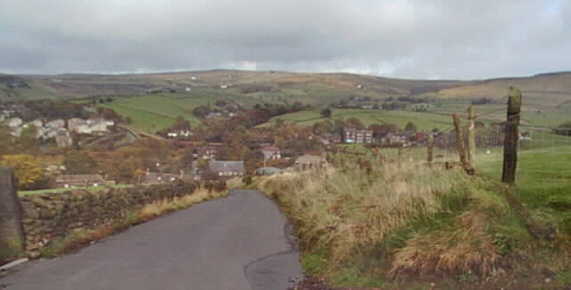
View across Diggle looking towards Standedge.
The canal was due to open five years after work on it had begun. However, when 1799 arrived, while the canal had been constructed to each side of the tunnel, the tunnel itself was far from open.
The construction of the tunnel was beset by many problems, many of these being due to poor organisation. The excavation of the tunnel began at both ends but after a while it was realised that the Diggle end was being constructed several feet higher than the Marsden end.
In correcting this, previous work was undermined, causing several collapses. There was also a persistent problem of large quantities of water seeping into the workings and in one year only 150 yards of tunnel was excavated.
The canal's engineer, Benjamin Outram, had many other commitments so that most of the canal construction had taken place under the supervision of a young, inexperienced surveyor, Nicholas Brown. Some of the construction work was inadequate and was washed away by floods in 1799. This and the tunnel's poor progress almost caused the project to be abandoned.
More capital was raised and repairs carried out, but the company desperately needed the revenue from carrying goods, so a system was set up of transporting cargo by horse between the two completed sections of canal at Marsden and Dobscross.
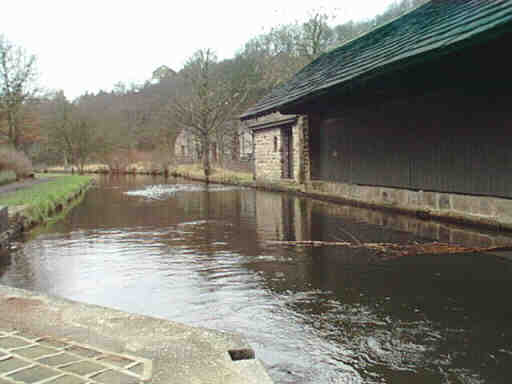
On the right is the transhipment warehouse at Wool Road, Dobcross. Goods were unloaded here to be carried by horse over the hill to Marsden.
After Outram's resignation, the well known engineer Thomas Telford was called in to advise on the tunnel's completion. Excavation had been taking place, not only from each end, but also from the bottom of the air shafts. (The spoil was hoisted up the shafts and dumped nearby, where it can still be seen.) This led to the tunnel being somewhat crooked and Telford discovered that, at one point, the two excavations were not going to meet and they were going to end up with two tunnels! Correcting this has resulted in the tunnel having noticeable bends!.
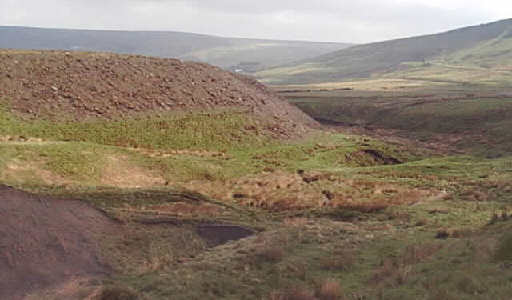
Spoil heaps from the tunnel excavations at Red Brook, near the Great Western Hotel on Standedge.
The tunnel was eventually opened in 1811 and the canal became a through route 17 years after work began. Using the tunnel wasn't an easy option for the boatmen, however. To keep costs down, the canal was built without a towpath. While the horses were led over the hill, the boatmen had to "leg" the boat through the tunnel, by lying on boards across the front of the boat and walking along the walls or roof of the tunnel, which took up to four hours.
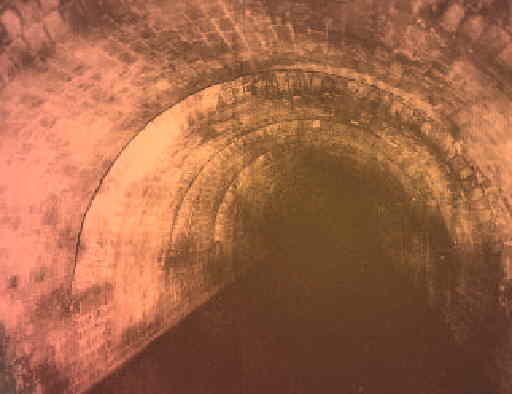
Inside Standedge tunnel. (Photo: Ken Wright)
Most of the tunnel was only wide enough for one boat. There were four passing places, but as the traffic increased and with time meaning money for the boat crews, there were frequent fights as crews refused to back off. The Canal Company decided that boats could only be propelled through the tunnel by its own official "leggers," and to operate a traffic control system. This involved only westbound traffic using the tunnel for a four hour period, then only eastbound during the next four hours.
The tunnel thus became an enormous bottleneck and resulted in processions of boats emerging from the tunnel only to have to queue to use the locks one at a time. Tailbacks are not just a feature of the motorway age! Much of the tunnel is brick lined, but the photograph above shows that parts of the tunnel are unlined with the surface being the hewn rock face, which would have made difficult work for the leggers..
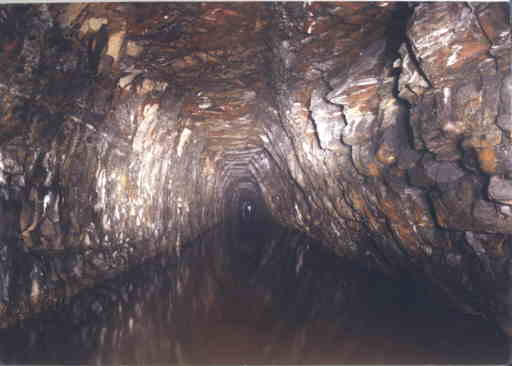
Standedge Tunnel - rock surfaced section. (Photo: Huddersfield Canal Society)
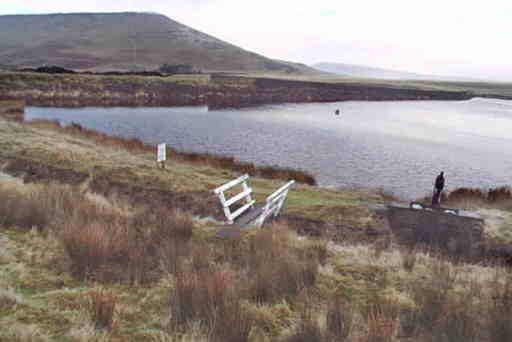
Redbrook Reservoir alongside the A62 on Standedge. This is one of 5 reservoirs constructed to maintain the water level in the top reaches of the canal.
So the canal took 17 years to construct rather than the planned 5 years. The costs rose to £396,267, which was more than twice the original budget. Standedge Tunnel alone cost £123,804 to construct. These figures are the equivalent of many millions of pounds at today's prices and gave the shareholders no return on their investment for 30 years.
However, the canal did enjoy a short period of relative prosperity until 1845, when it was bought by the Huddersfield and Manchester Railway Company, whose line was to follow a similar route to the canal. The railway company did not fear competition from the canal, but as they were building a tunnel alongside the canal tunnel, they wanted to use the canal to remove spoil from their excavations. They did this by boring short connecting passages so that boats could be loaded in the tunnel.
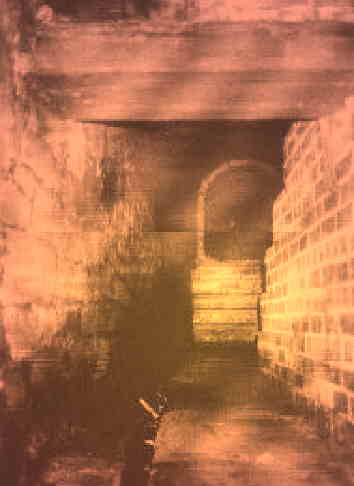
(Photo: Ken Wright)
Side passage in Standedge tunnel viewed from the canal tunnel. The original railway tunnel is beyond the doorway. The steps doubling back to the right lead across the canal tunnel to the rail tunnel used today.
Once the railway was open, the railway company had no reason to promote the canal, which fell into slow decline and was eventually closed in 1944.
In 1974 the Huddersfield Canal Society was formed with the objective of seeing a re-opening of the canal. This seemed extremely ambitious as whole sections had been filled in or even built over and several bridges had been removed to create nice, straight roads. However, with the hard work of volunteers, the backing of Kirklees, Oldham and Tameside Councils and British Waterways, and aided by grants and work schemes, the restoration of all the sections of canal that had not been infilled had been achieved by the 1990s.
The Huddersfield Canal Company was established to co-ordinate the work of re-opening the remaining sections of canal. The partnership with Tameside Council and the changing attitudes towards canals meant that when Asda built their new store across the Ashton Canal, on the site of the former Wharf Mill in Ashton, a tunnel beneath the store was constructed for the canal.
However, these enlightened attitudes came after some serious blockages of the canal had already been made.
Among the remaining obstacles to re-opening the canal were:
a) a stretch of just over half a mile, through Stalybridge, which has been filled in and partly built on.
b) a half mile in-filled stretch through Slaithwaite, luckily not built over.
c) two factories in Huddersfield extended across the canal.
d) a number of road bridges, including at Wade Lock, Uppermill and Wool Road, Dobcross, that had been removed to allow road widening.
(see below for link to pages about the restoration).
The Canal Company worked with the local authorities, British Waterways and property owners to overcome these costly obstacles. Luckily, funding from English Partnerships, the Millennium Commission and other sources enabled the re-opening of the blocked sections and the tunnel so that the whole canal bacame navigable once more in May 2001.